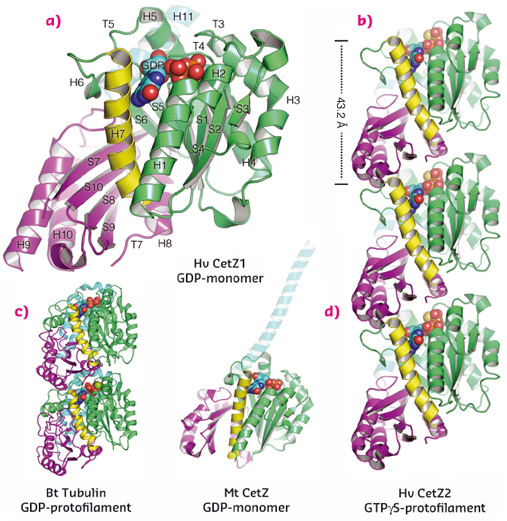- Home
- Users & Science
- Scientific Documentation
- ESRF Highlights
- ESRF Highlights 2015
- Structural biology
- Structures of archaeal tubulin-like proteins that control cell shape
Structures of archaeal tubulin-like proteins that control cell shape
Tubulin is an important protein in eukaryotes that assembles into filaments, controlling a cell’s internal structure and movement. A family of tubulin-like proteins was found to also control cell shape and movement in a major group of prokaryotes called archaea. X-ray crystallography revealed the structures of independent protein subunits and polymerised filaments of these proteins, shedding light on their similarities with eukaryotic tubulins.
Tubulins make up microtubules, a key filament of the eukaryotic cytoskeleton responsible for DNA segregation during cell division, the maintenance of internal cellular order and morphological features involved in cell motility, including flagella and cilia. In contrast, the most widespread tubulin homolog in bacteria, FtsZ, forms filaments that establish the cytokinetic ring during cell division. Only a few other bacterial tubulins are known, and they perform specialised roles.
While many archaea produce FtsZ proteins involved in cell division, we set out to investigate a large uncharacterised group of archaeal FtsZ-like genes with sequence features similar to eukaryotic tubulins. Deletion of one of these genes (cetZ1) in the haloarchaeon Haloferax volcanii abolished motility. Remarkably, we also found that these cells could not develop from the common plate-shapes seen in liquid cultures into rod-shaped swimmer cells. Mutation of a predicted key residue in the CetZ1 GTPase active site directly affected changes in cell shape, blocking rod formation, even though an unaffected copy of cetZ1 was also present. Interestingly, this mutant resulted in irregular cellular morphology and surface wrinkling, presumably due to hyperstability of CetZ1 polymers, since GTP hydrolysis is essential for polymer disassembly and turnover in tubulins. Our results therefore implied that CetZ1 polymerisation dynamics are required for its effect on cellular morphology.
 |
|
Fig. 132: Crystal structures of CetZs. (a) The crystal structure of Haloferax volcanii CetZ1 is shown with the secondary structural elements indicated according to the tubulin / FtsZ nomenclature. (b) The structure of a Haloferax volcanii CetZ2 protofilament. The tubulin dimer (c) is shown for the purposes of comparison. (d) The crystal structure of Methanosaeta thermophila CetZ. All full structures are shown from the same viewpoint in cartoon representation, with GTPase domains coloured green, activation domains coloured purple, H7 coloured yellow and the carboxy-terminal extension, H11, coloured blue. |
Given the mix of FtsZ-like and tubulin-like sequence features of CetZ1, and its close relatives in archaea, it was of significant interest to determine the 3D structures of CetZs. High-resolution X-ray diffraction (1.9 to 2.1 Å) was recorded from crystals of three different CetZs at ESRF beamline ID23-1 (two structures) and Diamond beamline I03 (one structure), and all three structures were solved by molecular replacement. We initially resolved the structure of a GDP-bound monomeric subunit of CetZ1, revealing that CetZs retain the canonical FtsZ / tubulin core fold (Figure 132a), with a C-terminal helical extension (H11) like tubulin, but without the N-terminal helical extension typically present in FtsZs. Given our anticipation of a cytoskeletal role for the CetZs, we attempted to visualise a CetZ polymer, screening CetZ1 extensively in the presence of GTP analogues, however no such crystals were obtained. A second CetZ homologue from the same species eventually yielded crystals containing tubulin-like protofilaments, showing that the polymerisation mechanism of CetZ proteins is consistent with archetypal tubulin and FtsZ protofilaments (Figure 132b and c). Finally, to confirm that CetZ orthologues were structurally consistent between archaeal species, we crystallised a divergent CetZ from Methanosaeta thermophila. The crystal structure of Methanosaeta thermophila CetZ revealed very similar morphology to both Haloferax volcanii homologues, most notably in the previously mentioned C-terminal H11 tail, implying conservation of the form, and presumably function, of the family.
In conclusion, our study identified a new and major group of the tubulin superfamily, confirmed, through structural and phylogenetic techniques, to be widespread in the Euryarchaeota, and provided the molecular and cell biological foundation for future studies of archaeal tubulins. Our study expands the known roles of the FtsZ/tubulin superfamily to include archaeal cell shape dynamics, implying that a cytoskeletal role for these proteins might have predated the evolution of the eukaryotic cell.
Principal publication and authors
CetZ tubulin-like proteins control archaeal cell shape, I.G. Duggin (a, b), C.H.S. Aylett (a), J.C. Walsh (b, c), K.A. Michie (a), Q. Wang (a), L. Turnbull (b), E.M. Dawson (b), E.J. Harry (b), C.B. Whitchurch (b), L.A. Amos (a) and J. Löwe (a), Nature 519, 362-365 (2015); doi: 10.1038/nature13983.
(a) Medical Research Council Laboratory of Molecular Biology, Cambridge (UK)
(b) The ithree institute, University of Technology Sydney (Australia)
(c) School of Physics, University of New South Wales, Sydney (Australia)



